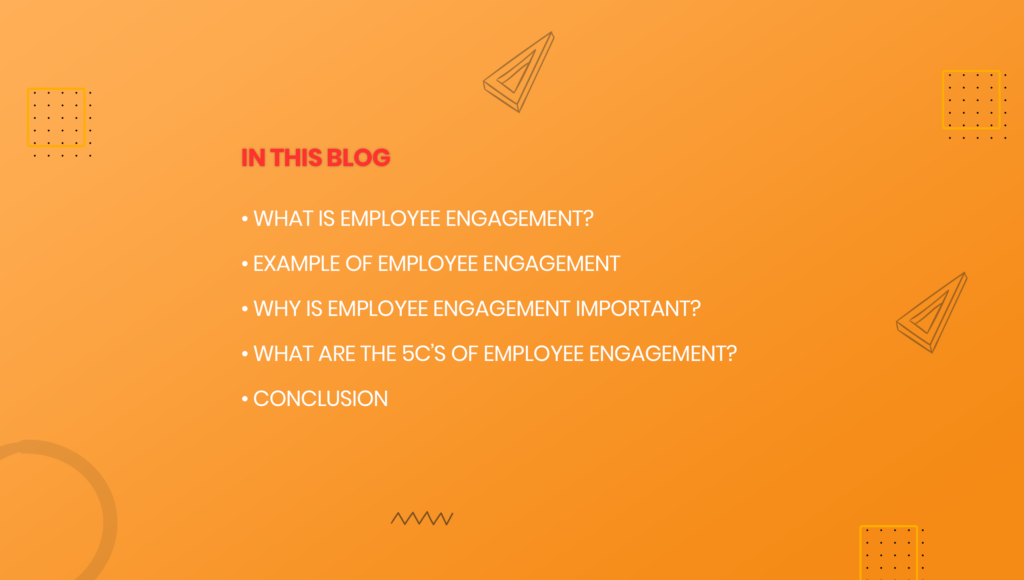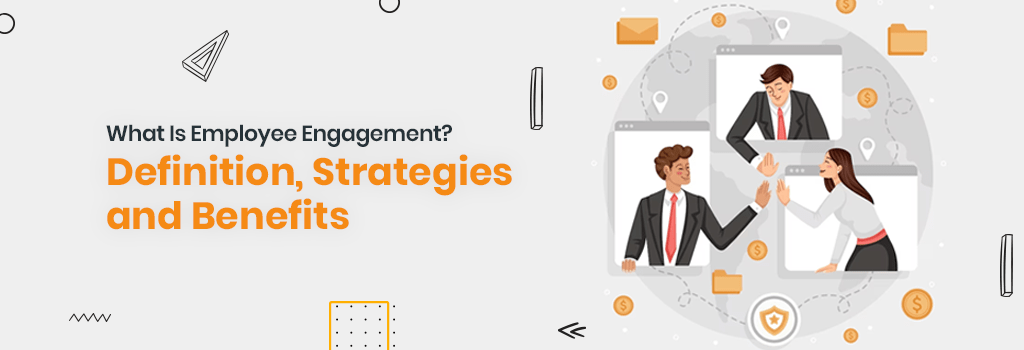Employee engagement is the catalyst that ignites productivity, innovation, and organizational success, making it an invaluable asset for thriving workplaces.

CRACKING THE CODE
We’re absolutely serious when we emphasize that employee engagement is quite possibly the most significant aspect you should prioritize.
In an era characterized by rapid changes and heightened competition, businesses face the pressing challenge of retaining top talent and maintaining a motivated, productive workforce. The answer to this challenge lies in understanding, nurturing, and enhancing employee engagement.
Yet, many organizations find themselves entangled in the web of employee disengagement, resulting in diminished productivity, soaring turnover rates, and even detrimental impacts on the bottom line.
From communication breakdowns to disengaged employees casting shadows on morale and productivity, the road to effective engagement is fraught with obstacles.
To effectively combat these issues, it is imperative to gain a comprehensive understanding of what employee engagement genuinely entails, why it holds such significance, and how it can be wielded as a strategic advantage.
This exploration embarks on a journey to unearth the definition, strategies, and the extensive benefits of fostering a culture steeped in employee engagement within the workplace.
WHAT IS EMPLOYEE ENGAGEMENT?
At its essence, employee engagement embodies the emotional commitment and enthusiasm that employees bring to their roles. It’s the intangible force that transforms routine tasks into passionate pursuits, turning colleagues into cohesive teams, and workplaces into vibrant communities.
In simpler terms, employee engagement reflects the extent to which employees feel dedicated to their work and the organization they’re a part of. It is a genuine sense of purpose and belonging where they’re emotionally invested in their jobs.
To gauge employee engagement accurately, organizations often employ tools like employee engagement surveys.
To harness the full potential of employee engagement, organizations should consider implementing regular employee engagement surveys to gauge the pulse of their workforce. These surveys delve into the workforce’s sentiments, seeking insights into their job satisfaction, alignment with company values, and feelings about them.
Employee engagement survey is a window into the collective psyche of the workforce, helping organizations identify areas that need improvement. It can help an organization have a more complete understanding of employee engagement. It is about fostering a work environment where employees are motivated to contribute their best.
The purpose of conducting an employee engagement survey is multifaceted. It aims to gain deeper insights into your employees’ perspectives and emotions regarding the organization. Through this survey, you can identify both problematic areas and areas of notable strength within the organization.
Additionally, it enables you to discern prevailing trends within the workforce. Most importantly, it conveys a powerful message to your employees – that their opinions matter, and the organization values their input as a means to enhance its overall functioning.
Organizations that prioritize engagement often experience reduced turnover rates, higher productivity, and improved overall performance. It’s the glue that binds employees to their roles, teams, and the organization’s mission, paving the way for collective success.
EXAMPLES OF EMPLOYEE ENGAGEMENT
Employee engagement isn’t a one-size-fits-all concept; it manifests in various forms, each contributing to a vibrant workplace.
Here are six examples of employee engagement strategies to jumpstart your initiatives and paving the way for a more engaged workforce. These employee engagement ideas will not only inspire you but also provide a practical foundation for constructing your action plan and effectively implementing it throughout your organization.
- Engaged organizations encourage open dialogues and honest communication. They provide avenues for employees to voice their opinions, concerns, and ideas, fostering a culture where everyone’s input is valued. Regular feedback loops, whether through surveys or one-on-one discussions, ensure that employees feel heard and appreciated.
- Engaged employers understand that growth is a powerful motivator. They offer avenues for employees to enhance their skills and advance in their careers, whether through training programs or mentorship initiatives. This investment not only benefits individuals but also bolsters the organization’s talent pool.
- Empowering employees to take the lead on projects or initiatives that align with their interests and skills can be highly engaging. Whether it’semployee engagementactivities, community outreach programs, or wellness initiatives, involving employees in decision-making and implementation can boost engagement levels.
- Employee well-being often provides wellness programs that focus on physical and mental health. These programs might include fitness challenges, mindfulness workshops, or access to counseling services, promoting healthier and happier employees.
- Recognition is a cornerstone of engagement. Engaged workplaces go beyond routine acknowledgment; they celebrate achievements and milestones, both big and small. From “Employee of the Month” awards to bonuses for outstanding performance, these tangible rewards show employees that their contributions are valued.
WHY IS EMPLOYEE ENGAGEMENT IMPORTANT?
A significant concern for employers is that only 36% of U.S. employees are categorized as engaged in their work. This alarming figure is a clarion call for organizations to address a critical issue that affects their very core.
Employee engagement is a fundamental factor that influences an organization’s success. The ramifications of low employee engagement extend far beyond the individual; they resonate throughout the entire business ecosystem.
From financial performance to market reputation, employee engagement is the compass that guides an organization through the turbulent waters of the modern workplace.
Organizations must delve into the intricacies of what drives engagement, why it wanes, and how it can be nurtured to flourish. By unraveling these intricacies, businesses can embark on a transformative journey toward fostering a highly engaged workforce that not only survives but thrives in the competitive arena of today.
Here are the results that underscore its positive effect on your business:
- Engaged employees are emotionally committed to their roles. This commitment translates into discretionary effort, where employees willingly go the extra mile. Studies have shown that highly engaged employees exhibit a 17% increase in productivity. Furthermore, organizations with a highly engaged workforce can experience up to a remarkable 23% increase in overall performance and profitability. This heightened dedication results in consistently high-quality work and exceptional outcomes.
- Employee engagement is closely linked to the quality of work. Engaged employees take genuine pride in their contributions, resulting in a higher level of attention to detail. They are less prone to errors and are more likely to deliver top-notch work. This, in turn, leads to enhanced satisfaction, reduced rework, and an improved reputation.
- Engaged employees have a clear understanding of the organization’s strategic objectives. They not only comprehend these goals but actively align their efforts to contribute towards achieving them. This alignment ensures that the organization stays on track to meet its long-term targets, fostering a cohesive and purpose-driven workforce.
- Employee turnover can be a significant cost for organizations, both in terms of recruitment expenses and the loss of institutional knowledge. Engaged employees are 87% less likely to leave their current employer. This not only reduces the need for frequent recruitment and training but also ensures that valuable expertise remains within the organization. These cost savings can have a direct and positive impact on the bottom line.
- Organizations known for their commitment to employee engagement possess a distinct advantage in attracting top talent. In today’s competitive job market, potential employees actively seek out companies with strong cultures of engagement. An organization’s reputation as an engaging and supportive workplace can set it apart from competitors when competing for the best candidates. This competitive edge in talent acquisition can be a game-changer, ensuring that the organization consistently has access to a pool of highly skilled and motivated individuals.
WHAT ARE THE 5C’S OF EMPLOYEE ENGAGEMENT?
Employee engagement is about creating an environment where employees are not just content but deeply committed to their work and the organization’s mission.
The 5C’s of employee engagement serve as pillars which collectively shape the employee experience and form the foundation of a highly engaged workforce. It represents a comprehensive framework for understanding and enhancing engagement within an organization.
By embracing the 5C’s—Catalyst, Commitment, Connection, Contentment, and Contribution—organizations can cultivate an environment that nurtures employee engagement but also drives business success.
These pillars serve as a blueprint for building a thriving workforce, where every employee is emotionally invested, connected, and motivated to contribute their best to the organization’s journey of excellence.
Take a look at our top 5C’s:
1. Catalyst – Leadership as the Driving Force
Catalyst represents the pivotal role of leadership and management in propelling engagement. Effective leaders act as catalysts for employee engagement by offering clear guidance, unwavering support, and growth opportunities.
They craft an atmosphere that sparks inspiration and motivates employees to excel. A compelling vision, regular feedback, and a culture of empowerment are key elements that effective leaders use to inspire and motivate employees.
2. Commitment – Emotional Dedication
Employee commitment reflects the profound emotional dedication and allegiance employees have toward their work and the organization.
Engaged employees exhibit unwavering commitment, as they wholeheartedly embrace the company’s mission and values. Their investment of time and effort is fueled by the alignment of their personal aspirations with the organization’s overarching objectives.
3. Connection – Fostering Relationships
Connection signifies the quality of relationships and the profound sense of belonging that employees experience within the workplace. Engaged employees often cultivate robust connections with their peers and supervisors.
They operate in an environment that encourages camaraderie, collaborative efforts, and open channels of communication. These connections create a supportive ecosystem where employees feel valued and appreciated.
4. Contribution – Active Participation
Contribution embodies the active involvement of employees in organizational affairs. Engaged employees transcend their job requirements, actively participating in innovative problem-solving, and proactively owning their work.
They are genuinely invested in the organization’s success and readily offer innovative employee engagement ideas and solutions by taking ownership of their roles and feeling a sense of responsibility for the organization’s growth. This level of contribution leads to innovation, continuous improvement, and a thriving organizational culture.
5. Contentment – Employee Well-being
Contentment correlates with an employee’s level of job satisfaction; it encompasses the overall well-being of employees. Engaged organizations offer work-life balance, mental health support, and opportunities for personal and professional development.
Engaged employees derive genuine fulfillment from their work. They perceive their tasks as meaningful and revel in a sense of accomplishment. This contentment serves as a powerful antidote against high turnover rates and fosters elevated morale.
WITH RYTFIT YOUR EMPLOYEE ENGAGEMENT STRATEGY TAKES SHAPE
No matter where you currently stand in your engagement efforts, we are dedicated to helping you craft the most exceptional experience for your employees, ultimately driving unparalleled success for your business.
When it comes to employee engagement, Rytfit.ai emerges as the optimal solution, tailored to businesses of all sizes.
Our platform is designed to empower you with the tools, insights, and strategies needed to foster a thriving workplace culture.
With Rytfit.ai, you have a dependable ally in your quest to define, refine, and amplify your employee engagement initiatives, ensuring that your organization not only survives but thrives in today’s competitive landscape.

